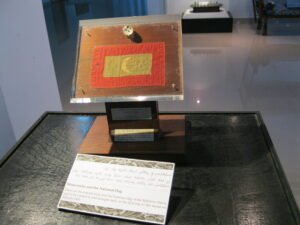The stones from the Moon have been gifted to many nations. Some are still on display in the museums, and some have been lost and later found. In some cases, it looks like a detective story.
Recently, I sorted out some images on my laptop and found interesting photos that instantly caught my attention. The pictures were taken by my father years ago during his business trip to Maldives. He happened to visit a local museum on Male’s capital island. Among the many images, one interested me the most. It depicts a podium with an exhibit that looks like five black dots the size of a grain of rice. These particles are packed in a miniature dome made of transparent plastic. Besides there is also a small Maldives flag. Two metal plates describe the content of the composition. It turned out to be the tiny fragments of lunar stones brought by the Apollo 11 mission from the Moon. The small flag was also taken aboard the spaceship and then given back to the government of Maldives, along with the five celestial stones taken from the lunar soil. All this story about the national flag which visited the Moon and unearthly rocks sounded like a fairy tale. The Maldives is known as a paradise for tourists, not a space-exploring country. But in fact, all this appeared to be true.

It happened 55 years ago when the Apollo 11 spacecraft successfully landed on the Moon’s surface on July 20, 1969, at 20.17.39 UTC. After more than half a century, the unusual gifts that Neil Armstrong, Buzz Aldrin, and Michael Collins brought back from the Moon are still in exhibition in the museum in Male. It looks symbolic: the Maldives flag with a crescent moon sign on it happened to travel to the Moon and back to the island.


The legendary lunar story began on July 16, 1969. On a summer afternoon at 13.32, three young American astronauts, Commander Neil Armstrong and two pilots, Buzz Aldrin and Michael Collins, boarded the Apollo spacecraft. In front of hundreds of thousands of spectators, the interplanetary ship was launched by a Saturn 5 rocket from the Kennedy Space Center on Merritt Island at Cape Canaveral, which belongs to the Sunshine State of Florida.
Apollo 11 consisted of three main parts. The Columbia command module with a cockpit was home to three famous astronauts during their journey to the Moon. Besides, there was the service unit and the lunar module. I wonder what the three astronauts talked about during such a long flight. Were they silent, or were they talking just about their space mission? I believe that in their thoughts, they kept warm memories of their sweet home.
They arrived at the destination point four days after the day of departure. Imagine it took only four days for the astronauts to reach the Moon and start walking on the lunar surface. An average driver would take the same time driving from Los Angeles to New York, including the stops for snacks and resting time. And if you can imagine traveling to the Moon at an average speed of 70 miles per hour, it would take at least 142 days. At 4:17 p.m. Eastern Time, Neil Armstrong radioed, “Houston, here is Tranquility Base.” Armstromn manually landed the Lunar module. At 20.17.39 UTC, a historic event occurred: for the first time, a man set his foot on the lunar surface. It was not a moonwalk performed by M. Jackson in 1983. The cautious steps appeared to be a giant leap for humanity, as it sounded in the famous Armstrong’s phrase. About 20 minutes later, Buzz Aldrin joined him to complete the mission. They stayed in the lunar soil for more than two hours. During that time, they managed to perform important space experiments, collect lunar samples with the help of special rakes, install an American flagpole, and take many memorable photos. By the way, Professor Mark Robinson, who manages the program for using the main camera of the LROC (Lunar Reconnaissance Orbiter Camera), wrote in his blog that American flags are still flying on the lunar surface.
Apollo 11’s triumphant return occurred on July 24 in the Pacific Ocean, about 1400 km (900 miles) west of Hawaii. After landing, the astronauts were quarantined for 21 days. During this period, they stayed in a large 58-room lunar receiving laboratory, where they were carefully checked for viruses they might have contracted on the Moon. All the lunar trophies underwent a scrupulous, rigorous examination.
NASA astronauts brought neither diamonds nor gold bars to Earth, but lunar dust and stones. The space treasures were handed over to the President of the USA, Richard Nixon. In 1970, on behalf of the American state, he donated the samples of lunar soil not only to 50 states of the United States but also to 135 friendly countries, including the Maldives. And the very fact that the Island State in the Indian Ocean for more than half a century has carefully preserved and protected that precious gift deserves deep respect. Now, the residents of the city of Male and the tourists can visit the National Museums of the Maldives and see five moonstones with their own eyes.
Unfortunately, not all the lunar samples have such a happy fate. Some, after a brief flash of world interest, faded away forever. For some cosmic gifts from Apollo 11, earthly life turned out to be complicated and confusing. Some lunar gifts disappeared without a trace due to miscounting in museums or political intrigues; others were sold on the black market or quietly taken away from public attention and hidden in private collections. Sometimes, they were accidentally mistaken for garbage and ruthlessly thrown away because the people in some countries and American cities were negligent in treating valuable gifts from the Moon.
It has to be mentioned that sad stories about the moonstones happened not only after the Apollo 11 mission. Unfortunately, the same stories occurred after all subsequent NASA flights to the Moon from 1969 to 1973, including Apollo 17. The history of lost and found lunar rocks sounds like a detective story. Some of them have a happy ending, and some cases remain mysteries.
In 1973, the citizens of Anchorage enjoyed seeing the exhibition of the Moonstones in the Museum of Transportation and Industry. But the joy didn’t last long because in September of the same year, a fire broke out in the museum under dubious circumstances, and the fate of the moonstones fell into the category of missing items. Everything in the building had been burned down except for the moonstones exhibit. Some museum employees claimed they had seen them unharmed in a glass showcase after the fire. The relentless fire had spared the space artifacts. But later, after cleaning works, the stones disappeared without a trace. The story of the Anchorage moonstones may have a sad end if not for the personal involvement of Joseph Guthheinz and his team at the Moon Rock Project. In 2002, a former NASA investigative agent and later a lawyer and college professor organized a private worldwide mission to find the missing moon rocks.
Joseph Gutheinz probably would not have achieved such grandiose results without his team of devoted students participating in his Moon Rock Project. As part of this program, about 1,000 students were involved for ten years in the search for missing moon rocks worldwide. In 2010, Elizabeth Riker was a graduate criminal justice student and a Moon Rock project member. Her task was to find the lost stones of the good Apollo 11. She took the matter with great responsibility. In the summer of 2010, she wrote an article for Capital City Weekly’s regional newspaper. She reported her conclusions about the absence of the moonstone and plaque donated to the state. And thanks to such an article, Texas resident Coleman Anderson learned that the lunar stones, which he had possessed at his home, are a very valuable thing. Back in 1973, young 17-year-old Coleman Anderson took part in cleaning works after a fire in a museum building in Anchorage. His stepfather worked at that time as a museum curator. Coleman Anderson discovered an exposure of moon rocks between the rubbles and garbage. According to his account, he had saved the moon gift from damage and had taken care of it very well. He believed that for such almost paternal care, he should receive compensation for protecting the memorial plaque or become its legal owner. During the trial, Coleman Anderson claimed that the lunar samples were stored somewhere far away, abroad. He demanded fair pay for the return of the moon samples. He even offered some discounts for the state of Alaska. Finally, Anderson returned the missing moon rocks on December 7, 2012.
The Apollo 11 stones gifted to Ireland were put on public display at the Dunsink Observatory in Dublin and damaged by a fire on October 3, 1977. Unfortunately, unlike in the Anchorage story, nobody there managed to save the priceless rocks during the cleaning works. This “pot of gold under the dump,” as Joseph Guthuintz called the discarded moon rocks, was inadvertently taken along with other debris to the nearby Finglas junkyard.
And a real detective story happened with the lunar stones gifted to Nicaragua. At first, they were kidnapped by a mercenary from Costa Rica. Then, the robber handed his cosmic catch to the Baptist missionary Harry Coates in exchange for some goods. The missionary later profitably sold them to the owner of the Las Vegas casino, Bob Stupak. The tycoon proudly displayed his lunar acquisition at his Moon Rock Café. Later, he probably realized it would be better not to publicly show such an unusual souvenir and hide it in a safe deposit box. In May 2012, two and a half years after Tupac’s death, his lawyer, Richard Wright, told NACA about the existence of the lunar rarity. Thus, the moonstones of Nicaragua, having survived the complex labyrinth of fate and the procedure of authenticity, in November 2012 happily returned to the people of Nicaragua.
Francisco Franco, the former dictator of Spain, believed that Richard Nixon gave the lunar stones to him personally and not to the entire state. Instead of considering the souvenir a national treasure, Franco appropriated it personally. After Franco’s death, his granddaughter claimed that her mother had lost the moonstones. However, there are rumors that the valuable lunar souvenir was allegedly sold to a buyer from Switzerland.
A ridiculous mishap occurred with the Moon rocks in the New York museum. The gifted stones were not listed in the museum’s records, and their whereabouts are unknown.
The Swedish sample was stolen by unknown persons from the Swedish Museum of Natural History in September 2002. This sad list of lost and never-found items can be continued.
I think humanity did not fully appreciate the importance of flights to the Moon, which happened more than half a century ago. Since then, no human has managed to step on the lunar soil. Of course, throughout the years, space exploration has continued. There are bright examples of successful missions of the automatic stations to the Moon and Mars. But it seems humanity lost keen interest in space events after the great leap in 1969, stuck in mundane problems. Cold War, arms race, and endless military conflicts distract humanity from vital global issues. The countries waste immense resources for military purposes. The best achievements in science and technology are used for destruction. As a result, people appeared to be the biggest enemy of their planet, Earth, acting like aliens. And space exploration is not an exception. The world powers consider space as a future battleground. The situation seems to be hopeless. But now I am listening to the immortal John Lennon song “Imagine..” and think there is always hope for deliverance. From time to time, we can hear the good news about planned manned journeys to the Moon and Mars. Some claim they will send people to Mars in the nearest years; ten years later, there will be a significant human colony on the red planet. Some look at these plans somewhat skeptically. But still, there is hope for a bright future for mankind. It is worth seeing the moonstone brought by the first men on the Moon as a reminder of the better days full of bright promises. Humans can join all their material and intellectual resources to explore space and make another great leap. And it is not about the Moon or Mars. It is about our unique planet Earth. Humanity can still avoid the dangerous point of no return or so-called “singularity “and save our planet and themselves. Mankind has to cherish its birthplace to have a secure, beautiful nest where they can always return after interplanetary journeys. The moonstones gathered by Apollo 11 remind us that it is time to stop throwing the deadly, mass-destroying toys. It is a time to gather the stones.




